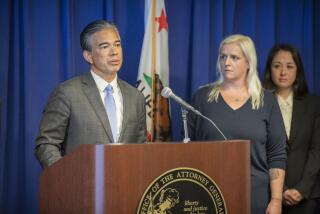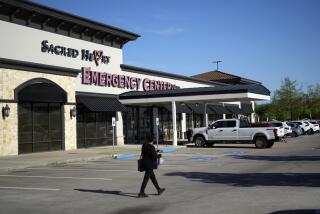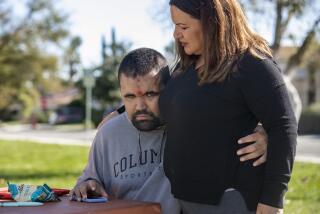They Want to Grieve : Family of Comatose Man Says Modern Medicine Should Allow Him the Dignity of Death
- Share via
During the past four years, Arturo and Adalgisa Sanchez have watched their athletic, vivacious teen-age son become a comatose, bedridden man barely clinging to life.
It is easier for Adalgisa Sanchez to talk about her 21-year-old son, Jesus Arturo Sanchez, as he was before an automobile accident in 1984 left him brain-damaged. That fall, Jesus would have started his junior year in high school. He was excited about trying out for the football team and playing drums in the school band.
Today, he lies unconscious at Fairview Developmental Center in Costa Mesa, kept alive by a feeding tube inserted into his stomach.
On Sept. 2, Orange County Superior Court Judge William F. McDonald denied the family’s request for a preliminary injunction that would have forced officials at Fairview to remove the tube and allow Jesus to die naturally. The family plans to file a petition with the state Court of Appeal, their attorney said.
The debate over whether to withhold or withdraw life-sustaining procedures from terminally ill patients has drawn national attention during the past decade. Doctors and hospital administrators, claiming it is a moral and ethical decision involving the sanctity of human life, often are pitted against family members, who say they are fighting to allow their loved ones to die with dignity.
At least two other so-called “right-to-die” lawsuits have been filed in Orange County this year, both involving elderly patients at convalescent hospitals. The Sanchez case is the first involving a state developmental center, officials said. The state’s seven developmental centers are publicly run centers for the mentally and severely physically handicapped.
While appeal courts nationwide have upheld a patient’s right to refuse medical treatment, the California Supreme Court has yet to address the issue, and there are no state-mandated guidelines for removing life-support systems.
Physicians and nursing home administrators say they are reluctant to remove mechanical life supports for both ethical and legal reasons.
Because the Hippocratic Oath, the pledge that all physicians take, commits the practitioners to preserve human life, health officials insist they have little choice but to keep their patients alive. They also say they fear that their licenses could be revoked if they agree to terminate life-support measures. And hospitals and nursing homes fear they could be held criminally liable in the death of the patient.
“The reason these cases arise very often is because physicians and administrators of facilities are uneasy about whether this is legally proper or not. So they force the family to go to court and litigate the issue,” said Byron Chell, general counsel for the California Medical Assistants Commission and a lecturer in bioethics at the UC Davis School of Medicine.
“Usually when the court issues a ruling, everyone feels more comfortable and they go ahead and comply with the family’s wishes.”
Ronald Cook of Long Beach filed a lawsuit in Orange County Superior Court on Aug. 1 seeking to force officials at Beverly Manor Convalescent Hospital of Seal Beach to remove the nasogastric tube that supplied food and fluids to his 76-year-old mother, Genevieve Margaret Cook.
She was placed in Beverly Manor six years ago after suffering multiple strokes and other neurological diseases that left her senile and incompetent, the lawsuit said. Court documents described her as bedridden and unresponsive to her environment.
“What I wanted to happen was for her to be able to die a natural death,” Cook said. “She has not been with us for a long, long time, and there is a lot of sadness when I go to see her.”
Cook said he has no doubt that his mother does not want her life prolonged artificially.
“When she would see someone on TV . . . where somebody would be in that kind of state of limbo, . . . she just deplored the idea. It seemed like a kind of hell on earth to her--and that’s the kind of phrase she would have used.”
Four days after Cook filed suit, hospital officials agreed to remove the tube. The officials refused to say why or to comment on the suit. But Cook’s mother is now being spoon-fed.
‘In a way, I’m relieved now,” Cook said. “I know that my mom is a lot more comfortable.” Although he is not actively pursuing the suit, Cook has not withdrawn it.
In May, Frances Hornsby filed a lawsuit to stop Buena Vista Convalescent Hospital in Anaheim from connecting a nasogastric feeding tube to her 83-year-old father, Stephen Armour Sprague.
According to the suit, Sprague suffered several strokes five years ago that left him bedridden and minimally responsive. Hornsby, who lives in Anaheim, said she sued in advance of any move to connect a tube because she believed hospital officials would do so if her father became unable to eat manually.
Orange County Superior Court Judge John C. Woolley ruled that the request was premature and refused to grant a court order. Hornsby has since decided to drop the case, said Richard Scott of Santa Monica, who represented the families in all three Orange County lawsuits.
Although the Sanchez family has filed suit seeking a court order to allow their son to die, the family members sometimes wonder whether it was the right decision.
“I don’t know if we are doing the right thing or not . . . but this is something we are doing out of love,” Adalgisa Sanchez said. “To see your child helpless there is difficult. You have to really go through it to know what it’s like.
“These respirators and feeding tubes are too mechanical. The body is not responding the normal way . . . the body reacts because you had something to make you react. That is prolonging your death. What life is there left?
“I thought by removing the tubes, he could rest peacefully. I never thought it would be this difficult.”
In 1976, the California Legislature became the first in the nation to pass a Natural Death Act, which allows a competent, terminally ill patient to sign a “living will” instructing doctors to cut off life-sustaining treatment. The law requires that two physicians certify the patient as terminal, mandates a 14-day cooling-off period before the will can be signed, and requires two witnesses who have no connection to the patient. The living will must be renewed every five years.
The state’s Durable Power of Attorney for Health Care Act, passed in 1983, allows an adult of any age or state of health to direct his or her future care and designate a surrogate for the day when he or she may be unable to make decisions.
These legal provisions offer patients in California ways to ensure that their wishes are carried out should they become incompetent, but few people are likely to have the appropriate documents when the problem arises, experts said.
A bill pending in Sacramento would make the 1976 statute easier to use. Sponsored by Sen. Barry Keene (D-Vallejo), who authored the Natural Death Act, it would eliminate the waiting period and would include patients in comas or in a “permanent unconscious condition” as well as those who are terminally ill. That bill has been passed by both houses of the Legislature, and is on the governor’s desk. A spokeswoman for Gov. George Deukmejian said he has not decided whether to sign the measure.
In four recent cases in California, state courts of appeal have reaffirmed the patient’s right to refuse treatment, even at the cost of life. In Drabick vs. Drabick, the most recent case, the Sixth District Court of Appeal ruled in April that family members may assert that right when the patient is incompetent. No cases have reached the California Supreme Court.
The Department of Health Services’ Division of Licensing and Certification--the agency that regulates convalescent homes and hospitals--last year adopted guidelines that essentially say any medical therapy can be withdrawn if the patient so desires. Officials said the guidelines were developed to provide guidance for state evaluators when investigating complaints or incidents.
Hospitals and other medical facilities must develop their own guidelines and standards, said Teresa Hawkes, deputy director for licensing and certification for the state Department of Health Services. Many nursing homes have used the state guidelines to establish their own policies, although they are not required to do so, Hawkes said.
“I can’t understand what the problem is,” attorney Scott said. “The state guidelines say a person--not a facility and not some board of directors . . . --gets to decide how much care to give. If the person becomes incompetent, it reverts to the relative, not the hospital.”
But hospitals argue that they cannot be sure the relative is carrying out the wishes of the patient.
The state guidelines require, among other things, that there be a clear written statement from a doctor stating that there is no reasonable possibility the patient will recover and certifying that the patient expressed, while competent, his or her wishes not to be kept alive artificially. A medical order by a physician also is required before care can be withdrawn.
“We were caught in the middle (before the state guidelines), since we are the ones who deal with long-term care facilities,” said Dr. Pat Chase, a medical consultant for the state licensing agency. “A lot of people won’t do anything because they are scared they will lose their license.”
“We are saying it is not our choice to make. We do have an obligation to see that decisions are processed appropriately in terms of the patient’s protection and that the facility is not blamed if the process is not correct.”
Officials at Fairview Developmental Center, the Costa Mesa institution where Sanchez is cared for, face a similar problem, said Hugh Kohler, executive director at Fairview.
“We have a very pro-life position. We are very uncomfortable with requests to deny people appropriate treatment, such as pulling the plug or denying them food or hydration.”
Although Sanchez is comatose, he is responsive to certain kinds of stimuli, Kohler said, and the hospital’s opinion is that he is not in a vegetative state.
“It’s a big question mark exactly what will happen to him, but we don’t want to make a decision relative to the quality of life for him. We feel that individuals should make their own decisions,” Kohler said.
The policy not to remove life-sustaining systems applies to all developmental centers in the state, said Banford Frankland, deputy director of the state Department of Developmental Services, which regulates Fairview.
“The Sanchez boy was given to us for care. He has not been committed in the sense that he is our permanent responsibility. The parents have an option of selecting a different location for their son. There are possibilities that their wishes could be carried out at a different location,” Frankland said.
But 95% of the patients in the state developmental centers are supported by Medicaid, and families are required to pay little or nothing for their medical care, Frankland said. Sanchez’s parents said they are paying nothing for their son’s care at Fairview.
The dilemma has posed other problems for Arturo Sanchez, 52, a sales representative, and his wife, 48. They also have a 24-year-old daughter.
“We are suffering because of his condition,” Adalgisa Sanchez said. “We haven’t even had the privilege, you might say, to grieve because he hasn’t been there for the last four years, and still his body is there. You are born, you live and you die. But like this, he’s just there.”
Mrs. Sanchez said her son has undergone several operations since the accident, and that for the last four months he has been ill with temperatures of up to 106.7 degrees. Last year, he was taken to the UC Irvine Medical Center, where he was treated for fever and returned to Fairview.
“God has called him many times, but mechanical tubes and medical technology have interfered. Where is his dignity?” she said.
More to Read
Sign up for Essential California
The most important California stories and recommendations in your inbox every morning.
You may occasionally receive promotional content from the Los Angeles Times.










